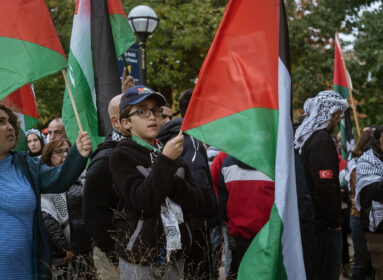By Dr. Richard Freund

Rabbi Marshall Meyer. Photo Courtesy of
the Marshall T. Meyer Human Rights Archive at the David M. Rubenstein Rare Book and Manuscripts Library, Duke University
In August 1959, a 29-year-old graduate of the Jewish Theological Seminary, Rabbi Marshall T. Meyer, arrived in Buenos Aires with his wife, Naomi, to serve as assistant to Rabbi Guillermo Schlesinger, leader of the most prominent synagogue of Latin America, the Congregacion Israelita of the Argentine Republic, or CIRA. Marshall and his wife planned to stay for two years and ended up staying for 25, revolutionizing Latin American Judaism and then returning to the United States to try to do it in North America.
Post-World War II Argentina, like most of Latin America, was filled with Jews who had either come in the 19th and early 20th century from Europe or were displaced persons who had sought refuge after the Holocaust. By 1950, the Jews of Latin America were segmented, with secularists, Yiddishists, socialists, and Orthodox-styled sectarians.
Meyer, who went on to become an internationally renowned advocate for human rights, believed it was necessary to create an extremely fluid, modern, Latin American Jewish identity that would be meaningful to all Jews and intelligible to their non-Jewish neighbors.
In his first few years in Argentina, he tried to replicate the Conservative religious revolution that had evolved over nearly 100 years in the United States, starting with youth movements and camping. In addition to a seminary, he launched a Jewish publishing revolution in Latin America, and started one of the fastest growing “Jewish camping” movements that is based in the synagogues from Mexico to Tierra del Fuego.
Meyers passed away on Dec. 29, 1993, before his 63rd birthday, and was buried in the cemetery of the synagogue of his hometown in Norwich.
In commemoration of his work, this spring the Maurice Greenberg Center for Judaic Studies at the University of Hartford will be sponsoring an open series of lectures on Latin American Judaism, as well as a ‘Spring Break’ trip to Argentina (March 13-20, 2014) that will include visits over Purim and Shabbat to synagogues that the rabbi inspired, study at the Seminary that he founded, and meetings with Argentines that have been affected by his life and legacy.
From Connecticut to New Hampshire and Beyond

Latin American Rabbis with Rabbi Meyer (center) and Rabbi Reuven Hammer, USA,Rabbi Meyer and Rabbi Theodore Friedman (Israel) on either side of him.
Rabbi Marshall T. Meyer is probably the most well known rabbi who grew up in Connecticut in the 1930s and 1940s that you probably have never heard about. A graduate of the Jewish Theological Seminary in New York City, it is said that he saved Latin American Judaism twice: The first time, when he created the only modern rabbinical seminary of Latin America (Seminario Rabínico Latinoamericano — Seminario or SRL, for short) in Buenos Aires in 1963; the second time, when he created a human rights movement that helped bring down the right wing government that had spread like a cancer in Argentina (and other Latin American countries) in the 1970s and early 1980s, and rescued Jews and non-Jews from the terror of their own governments.
It is strange to think that it all began with his upbringing in Connecticut and his education at a college in New Hampshire.
Rabbi Meyer’s developing human rights conscience was partially a result of his education with a special professor at Dartmouth College in the late 1940s and another professor at the Jewish Theological Seminary in the 1950s. His early religious identity was formed in Norwich, in a small New England Conservative congregation in the pre-World War II era. He went to Dartmouth College in Hanover, N.H. and fell under the influence of a famed social philosopher and thinker at the school, Eugen Rosenstock-Huessy. This connection with Rosenstock-Huessy provided Marshall with a perspective on the world, and especially religious thinking, that continued throughout his life. In his commencement address at Dartmouth in 1988, Meyer acknowledged: “I am a rabbi primarily because of Professor Eugen Rosenstock-Huessy.”
This is interesting since the professor struggled with his religious identity his whole life. Rosenstock-Huessy’s work spanned the disciplines of history, theology, sociology, linguistics and beyond. He was born in Berlin, Germany in 1888 into a non-practicing Jewish family, the son of a prosperous banker. He converted to Christianity in his teens. The interpretation and reinterpretation of Christianity was a recurring theme in his writings. He also was examining how it was possible to change entire societies through educational institutions that were based upon ideological and societal concerns.
Rosenstock-Huessy left Germany in 1933 with the rise of Hitler; but if we look at the educational career of Meyer in relation to Rosenstock-Huessy – and especially Meyer’s social activism – it is one which took many of his professor’s ideas and transformed them into a practical form in Latin American society.
As I look for the thread of this influence in the writing of Rabbi Meyer (his sermons, letters, etc.), it is possible to see that basically he was transforming the religious thought of his

1972: The first two graduates of the rabbinical school (Rabbi Reuven Nisenboim, left,and Rabbi Angel Kreiman-Brill)
are ordained while student Baruch Plavnick holds the corner of the tallit.
professor into a system that would help him navigate governmental forces in Argentina which were similar to the forces that Rosenstock-Huessy faced in Germany in 1933. Rosenstock-Huessy went to the United States; Marshall Meyer stayed in Argentina and fought the injustice that he felt violated the civil rights of not only Jews but all Argentines.
In addition, also the religious ideology of Rosenstock-Huessy and Meyer are amazingly similar. Rosenstock-Huessy was trying to reinterpret Christianity in light of the continued existence of Judaism, while Meyers was trying to interpret and reinterpret the significance of Judaism in light of the modern period [in the context of Conservative Judaism in Latin America].
His studies with Rosenstock-Huessy, however, were also a preparation for his studies at the Jewish Theological Seminary in a way that no other teacher could have prepared him for – and also preparation for his work with Rabbi Abraham Joshua Heschel. The writings of Heschel (in translations that were carefully crafted by MTM in Spanish) and the influence of his ideas for Latin America are quite different from Heschel’s influence upon North American, European and Israeli religious life.
The reasons are manifold, but it is clear that Heschel’s work benefited from having a “prophet” like Rabbi Meyer. It is clear that what Rabbi Meyer learned from Heschel was how to teach students “to pray with their feet.”
Refounding Bnai Jeshurun
Most people know of Rabbi Meyer in the United States because he re-founded one of the most important North American Congregations upon his return to New York in 1985. Founded in 1825 and located on West 89th Street in Manhattan, Bnai Jeshurun – or BJ, as it is affectionately called – was once one of the most prominent synagogues in America. In 1985, when I visited Rabbi Meyer after he assumed his duties as spiritual leader there, the synagogue was in disrepair, the Friday night service that I attended found ten people and the rain was coming through the roof! Today, when one attends a service at BJ on a Friday night or a Saturday morning or holidays, hundreds of young people fill the newly renovated synagogue to a vibrant service and led by two rabbis whose formative years were spent in Latin America!
In one of the more improbable scenarios, the North American revolution which Rabbi Meyer brought to Latin America in 1959 has been reversed; now, the Latin American revolution has come to influence North American — and world — Judaism, primarily through the almost 100 rabbis, hundreds of educators and cantors, as well as the youth leaders trained at the Seminario that serve all over Latin and North America, as well as Europe and Israel.
Dr. Richard Freund is director of the Maurice Greenberg Center for Judaic Studies at the University of Hartford. He worked with Rabbi Meyer in Argentina as the rabbi transitioned from 25 years in Argentina to his new challenges in the United States in 1984. He is currently writing a history on the occasion of the 50th anniversary of the Seminario.
Fairfield’s Rabbi Kormis remembers Rabbi Meyer
FAIRIFELD — Rabbi Marcelo Kormis became spiritual leader of Congregation Beth El in Fairfield in 2012. A native of Santiago, Chile, he received a teaching certificate from the Abarbanel Institute at the Seminario Rabinico Latinoamericano in Buenos Aires, founded by Rabbi Marshall T. Meyer. He then studied in Israel, earning a B.A. in Bible and Jewish Thought from Haifa University and a Master’s of Jewish Studies at Machon Schechter in Jerusalem, and completing the Senior Educators Program for Jewish Education in the Diaspora at the Melton Center at the Hebrew University of Jerusalem. He received rabbinic ordination from Seminario Rabinico Latinoamerico.
Kormis then returned to Santiago, where he served as the head of Judaic Studies at the Instituto Hebreo, the largest Hebrew day school in Chile. He was associate rabbi of Comunidad Israelita de Santiago (now known as Circulo Israelita de Santiago), the largest Conservative congregation in the city.
Kormis met Rabbi Meyer when Meyer visited Congregation Or Shalom in Santiago, Chile as a guest of the shul’s spiritual leader, Rabbi Marcelo Bronstein.”
I was a young man at that time and I clearly remember how Rabbi Meyer’s d’var torah deeply inspired me,” recalls Kormis. “His words combined in a brilliant way the Chilean society of that time with the central message of the parsha. Later, during my rabbinical studies in Buenos Aires at the Seminario Rabinico. which he founded, I heard my teachers saying many times that Rabbi Meyer used to say that a Jew has to hold the Tanach in one hand and the newspaper in the other. His idea of combining tradition and modernity has inspired many rabbis across the continent and many more around the world.”
Reflecting on how Rabbi Meyer influenced Latin American Jewish life, Kormis calls Rabbi Meyer “a visionary.”
Says Kormis: “He was part of a handful of people that were able to make a real and long lasting change in the society in which they lived. His contribution to the Jewish life in Latin America was enormous. He founded two institutions that renewed and revitalized the Latin American Jewry: The Seminario Rabinico Latinoamericano. Since its foundation in 1962, eighty-eight rabbis have been ordained there. These rabbis all serve in different countries and continents spreading the values and messages of our tradition. In 1963, Rabbi Meyer founded one of the most prestigious congregations in Argentina, Comunidad Bet El. Until then Judaism in Argentina and Latin America was lived and experienced in a traditional way. It was the legacy of immigrants who came from Europe escaping from pogroms and wars. Marshall’s brilliance was to change the Jewish experience not only in its ritual, but also in its content. He introduced new melodies, the idea of egalitarian and combined tradition with change. He also founded Machane Ramah, a summer camp that served as a role model to other camps in the continent and that still is very successful and congregates many children during the summer; and he translated and edited important Jewish books to Spanish and edited the first bilingual Spanish/Hebrew Siddur and Machzor, which is still in use in many Conservative synagogues in Latin America.
“As one of my teachers once said: Marshall Meyer saved the Argentinian Jewry twice: the first time from assimilation and the second time from the moral decadence. Confronting the military government, saving dozens of people from death, Rabbi Meyer taught us how to stand strong on our beliefs and how to do the right things in the eyes of God and our fellow human beings.”
At the Greenberg Center Free and Open Lectures on Latin American Jewish Life
My Ancestors in Basso, Argentina in the Pampas and Argentine Jews Today
Monday, February 24, 4:30 p.m.
1877 Club, Room C
Leandro Galanternik, Director of Programs,
Seminario Rabinico Latinoamericano, Buenos Aires, Argentina
The History of the Jews of Latin America 1800-2014
Sunday, March 2, 2 p.m.
Mortensen Library, KF Room, Mortensen Library
Professor Richard Freund, Director, Greenberg Center
Latin American Judaism Study Tour, March 13-20
Seating is limited and reservations are required for lecture. For more information on the lectures or study tour, contact the Greenberg Center at (860) 768-4964 or mgcjs@hartford.edu.








 Southern New England Jewish Ledger
Southern New England Jewish Ledger









